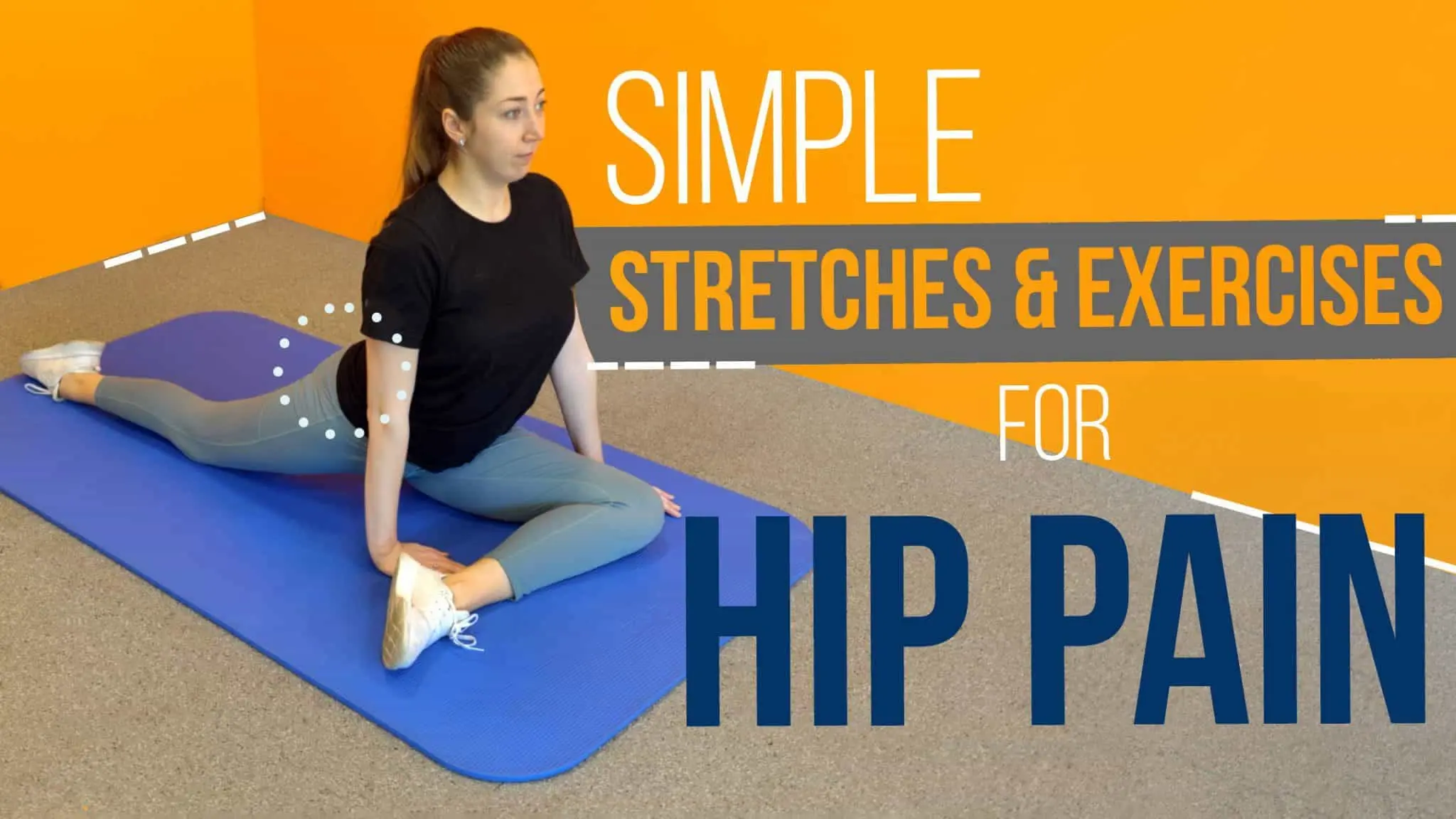Exercises for hip pain can help you get well from pain and its associated signs as well as strengthen your hips so you can carry out daily tasks more easily.
Hip pain can be caused by a variety of issues, from a minor injury to ongoing inflammation. Stretching and little exercise for the hips can often help reduce pain and increase the range of motion.
Exercise for hip pain is an essential part of your total treatment plan since it can reduce hip pain and strengthen and improve your hip joint, allowing you to carry out all daily tasks without experiencing excessive pain.
This article includes a variety of exercises that target hip pain, strengthen hip muscles, increase hip joint mobility, and encourage hip muscle flexibility.
What is a Hip Joint?
This joint, which is made up of a ball and socket structure, offers motion and stability for supporting body weight. The acetabulum, or socket region, is located in the pelvis. The ball of the hip joint is found in the femur. The acetabulum and femur bone connect to create the hip joint. One of the body’s most stable joints is the hip joint.
However because it bears your body weight, the additional stress from carrying that weight raises your risk of experiencing pain and arthritis. Damage to the bursae, tendons, or muscles that support and protect joints could result in a hip injury. They are small and have lots of wide spaces.
What can cause pain in the hips?
- Sciatica
- Labrum tear
- Trochanteric bursitis
- Fracture or trauma
- Bursitis
- Tendonitis
- Pregnancy
- Osteoarthritis
- Rheumatoid arthritis
- Iliotibial band friction syndrome
- Piriformis syndrome
Symptoms:
- A variety of symptoms may be present with hip restrictions and pain.
- Pain in the thighs
- Hip pain in the anterior
- Hip pain on the lateral side
- Back pain
- Having trouble moving your leg and hip
- Difficulty running, walking, or climbing stairs.
- Pain whenever standing up from a seated position
What is Hip pain?
There are times when hip pain spreads to the lower leg or knee. Joint stiffness typically exists with lower extremity pain, making daily activities challenging. Common actions that have an effect include putting on shoes, getting up from a chair, walking, or driving. Hip pain can occur in the front, side, or back of the hip joint.
This type of pain is common when nerves from the hip go down the leg and can radiate to the knee, lower leg, or thigh. They might specify joint or pain in the muscles.
How can hip pain be relieved by exercise?
Hip pain may result from a variety of factors, including inflammatory diseases, arthritis, and strained or injured muscles. All the same, mobility can often be restored and pain relieved with mild exercise of the hip muscles. For easier movement and injury prevention, strengthening the muscles in this area promotes flexibility and stability.
Exercises for strength and flexibility are important for reducing hip pain. These workouts shouldn’t generate or worsen pain, although the possibility of momentary discomfort. Exercise should be stopped if it hurts, or you could try going more slowly. While doing any of the exercises listed below, a person who has just undergone a hip replacement should speak with a physician or physical therapist.
How Do stretches help with hip pain?
Hip pain may be caused by tight muscles or capsular structures around the hip joint. Being a ball and socket joint, it should be able to move in the following directions: flexion, abduction, extension, and rotation. When these structures are used for activities like jogging or playing sports, tightness in the muscles surrounding your hips may make it more difficult for you to move effectively and raise your risk of injury. Stretches for hip pain can help your muscles become more flexible so that your hip joint can move freely and over its entire range of motion.
It’s important to move smoothly into each position when performing hip stretching exercises until you feel a slight pulling sensation around the targeted area. Every stretch should be held for fifteen to thirty seconds, and then you should carefully release the pose.
How Does Hip Pain Relieve With Resistance Exercise?
Reduced stresses on the joint and a reduction in hip pain can be achieved by strengthening the hip muscles. Your total functional mobility can be improved by increasing muscle activation surrounding the joint, which will make it easier for you to run or walk.
There are several kinds of hip resistance exercises. These could consist of weightlifting machines and workouts, resistance band exercises, and body weight exercises.
Weight training, however, might not be the greatest option if you are suffering from acute hip pain because it puts additional pressure and stress on your muscles and joints, which could result in further pain or injury. The right time to begin resistance training as well as which exercises are best for you and your condition can be determined by working with a physiotherapist.
Advantages of exercise for hip pain:
Regular exercise has the following benefits;
- The strengthening of the muscles has increased.
- Improves the effectiveness of daily exercise
- Improved range of motion leading to better posture or balance
- Relaxation of muscles
- Decrease pain
- Improve flexibility along with movement
- Fitness levels have increased
- Reduced chance of re-injury or future injuries
- Your capacity to tolerate pain has risen for your favorite daily activities.
The best exercise for hip pain:
Some of the best exercises for hip pain are listed below.
Knee lift
- Stretch both of your legs out along the floor while lying flat on your back.
- Pull the right knee up toward the chest while maintaining the left leg straight.
- For help with pulling the knee in toward the chest, place both hands on top of it.
- For a few seconds, hold the stretch.
- Release the knee and return the leg to the floor with little pressure.
- Then return to your neutral position.
- Then relax.
- Repeat on the opposite side.
- Repeat this exercise 5-10 times.

Double hip rotation
- Lay down flat on your back.
- After that, bend your knees and pull them toward your body until your feet are flat on the ground.
- Rotate the knees gently to the left, bringing them down to the floor.
- Holding the shoulders flat against the floor, turn your head to face to the right.
- For a few seconds, maintain this posture.
- Return your knees and head to their initial positions slowly.
- Then relax.
- Do the same on the other side.
- Repeat this exercise 5-10 times.
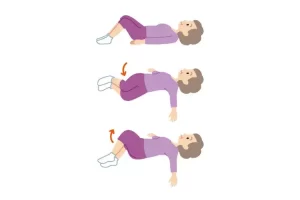
Hip and lower back stretch
- Bend your knees and move them toward your body while lying flat on your back until your feet are flat on the ground.
- Pull each knee in toward the chest with your hands.
- With every breath out, bring your knees up to your shoulders.
- Breathe deeply.
- Stretch to the limit of your comfort and hold that posture for a few seconds.
- Take a regular breath.
- Then return to your neutral position.
- Then relax.
- Repeat this exercise 5-10 times.
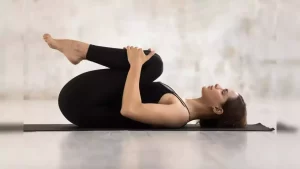
Hip flexion
- Take a straight position.
- Hold onto a solid object, like a wall, table, or chair, for support while extending one arm out to the side.
- Maintaining a straight left leg, gradually elevate the right knee to hip level or as high as feels comfortable.
- After only a few moments of holding this position, put the left foot on the floor.
- Then return to your neutral position.
- Then relax.
- Do the same with your other knee.
- Perform this exercise five to ten times.
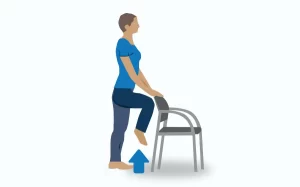
Hip extension
- Maintain a straight posture while keeping your feet shoulder-width apart.
- Spread both arms wide in front of you and grasp a chair, table, or wall for stability.
- Without bending the knee, raise the left leg backward while maintaining the straight right leg.
- Raise the leg to the greatest extent possible without causing pain, then gently squeeze the buttock.
- Maintain this position for a few seconds.
- Then return to your neutral position.
- Then relax.
- Do this stretch five to ten times for each leg.
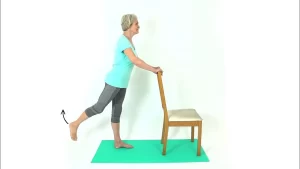
Hip abduction
- Your feet should be shoulder-width apart, and your posture needs to stay straight.
- Lean the left arm out to the side and grasp a sturdy object, like a wall, table, or chair.
- Raise the right leg out to the right side, starting with the feet together.
- Avoid turning your hips, and maintain a straight left leg.
- After five seconds of holding the pose, carefully bring the leg back to its original position.
- Then relax.
- On the other side, perform the exercise again.
- Perform this exercise five to ten times.
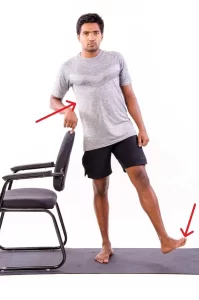
Heel to buttock exercise
- Maintain a straight posture while keeping your feet shoulder-width apart.
- If you need support, grab onto a chair, table, or wall.
- Bending the left knee toward the left buttock, lift the heel so that the top of the foot is toward the ground.
- Confirm that your right leg is straight and that your knees are in the proper position.
- Lower the leg gradually and take a step back to the beginning.
- Then relax.
- On the other side, perform the exercise again.
- Perform this exercise five to ten times.
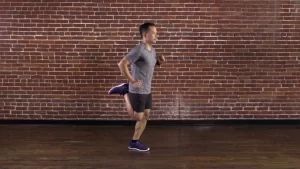
Bridging
- With your feet flat on the floor and both legs bent at the knees, lie flat on your back.
- With the palms pointing down, keep the arms by your sides.
- If support is required, put a little pillow under the head and neck.
- Raise your pelvis gradually, then raise your back.
- Make sure your upper body and shoulders stay on the ground.
- For five seconds, hold the position.
- Beginning at the top of the spine, progressively go down the pelvis and back toward the ground.
- Until the entire back is flat against the floor once more, move down into the spine.
- Then return to your neutral position.
- Then relax.
- Perform this exercise five to ten times.
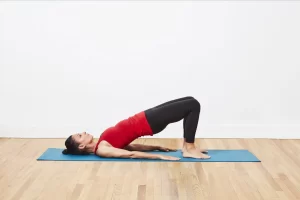
Chair stand
- Choose a sturdy chair with no armrests and sit close to the front end of it.
- With your feet flat on the floor, shoulder-width apart, under your hips, your knees should be bent.
- Lightly place your hands on the seat’s sides.
- Maintain a straight neck and back while raising your chest slightly forward.
- Inhale slowly.
- Bring your weight to the front of your feet by bending forward a little.
- As you slowly rise to your feet, exhale.
- Try to avoid using your hands to hold any weight.
- Breathe deeply in as well as out while keeping unmoving.
- As you slowly sit down, take a breath.
- Slowly take a seat again and resume your starting posture.
- To control your lowering as much as possible, tighten your abdominal and core muscles.
- It is best to slowly return to the chair rather than just falling back into the seat.
- Exhale slowly.
- Then relax.
- Perform this exercise five to ten times.
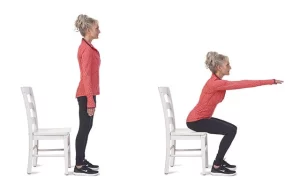
Hip flexor stretch
- Begin by bending both knees.
- Step one foot forward at this point and bend your knee to a 90-degree angle.
- If necessary, you can rest your hands on the front knee for support.
- keeping the upper body straight.
- Then bend forward until a stretch is experienced.
- For a few seconds, maintain this posture.
- After that, take a step back to a neutral position.
- Then relax.
- Do this five to ten times.
- Repeat while switching legs.
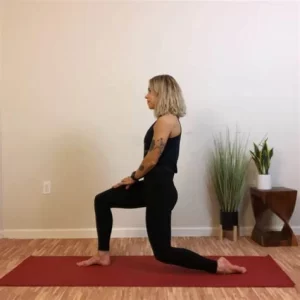
Butterfly stretch
- Place your legs in front of you while sitting down to begin.
- Grab your ankles now and move your feet in closer.
- After that, bring both of your feet together until your toes contact.
- Place your hands around your ankles.
- Apply pressure with your elbows to your knees.
- To bring the knees closer to the floor, apply light pressure.
- For a few seconds, hold it.
- Then slowly take a step back to your neutral stance.
- Then relax.
- Do this five to ten times.
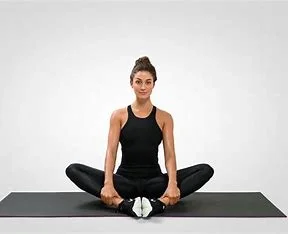
Pigeon pose
- Start by relaxing and placing your hands on your knees on the ground.
- Now squeeze your abdominal muscles.
- Next, extend your left knee to the left side and bring it forward.
- Bend your right toes under and move your right leg downward.
- Let your left toes drop.
- Maintain a straight back and upward focus.
- Keep your posture for a little while.
- After that, slowly get back to your neutral posture.
- Next, relax.
- Five to ten times repeat this exercise.
- Repeat the exercise with the other leg.
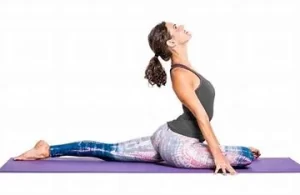
Piriformis stretch
- Lie on your back on the ground in order to begin.
- Bend each of your knees.
- Maintain a level foot contact with the ground.
- Put your right ankle next to your left thigh now.
- Put your hands behind your leg on the left side.
- Bring your thigh closer to your chest.
- Hold it for a short time.
- Return to your neutral posture after that.
- Next, relax.
- Five to ten times repeat this exercise.
- Repeat the opposite side.
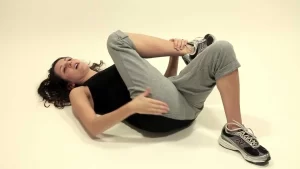
The Thomas Stretch
- To begin with, Legs swinging off the high couch or bed, sit near the edge of the object.
- At the same time as you raise one leg toward your chest, lean back onto the table.
- Keep it for a few seconds.
- Next, slowly lower your leg.
- Then slowly take a step back to your neutral stance.
- Then relax.
- Do this five to ten times.
- Repeat on the other side.
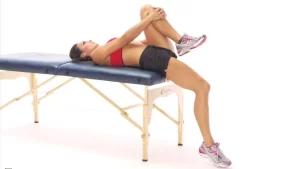
Seated Hamstring Stretch
- Sitting on the bed, yoga mat, or table, maintain proper posture.
- With the leg, you wish to stretch straightened, place your heel on the floor with your toes free and pointed upward.
- Keep your back flat, lean forward at the hips, and shift your weight.
- Maintain your forward trunk flexion until you experience a stretch in the lower part of your leg.
- For a short while, maintain this posture.
- After that, take a step back to neutral.
- Then relax.
- With the other leg, carry out the same movement.
- Do this exercise five to ten times.
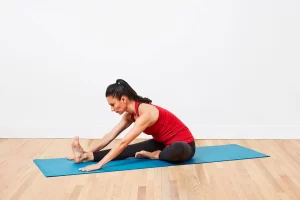
Straight Leg Raise
- Start on the floor or table in a comfortable lying down position.
- Now flex your knee a little.
- Then slowly lift your leg.
- while the opposing knee remains straight.
- After that, hold for a short while.
- Next, bring your leg down.
- Go back to your neutral position slowly.
- After that, relax.
- Do the same on the other side.
- Repeat 5–10 times on each side.
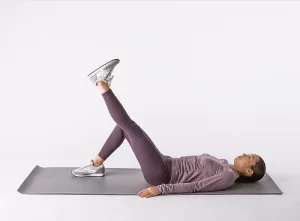
Hamstring Band Stretch
- Place yourself on a yoga mat on your back.
- With a slightly bent knee, raise one leg off the mat.
- Cover the extended leg’s foot sole with a resistance band.
- Pull the leg in as close to your chest as is comfortable.
- For a short amount of time, maintain this point of view.
- Return to your neutral position after.
- Next, relax.
- Continue with the opposite leg.
- Do this five to ten times over.
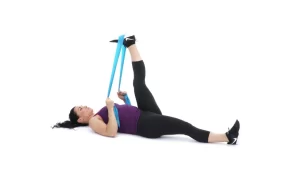
Prone hamstring curl
- A resistance band’s ends should be attached to a strong object.
- Spread your feet hip-width apart while lying on your stomach.
- Flex your ankle after wrapping the band around one of your heels.
- Bend your knee and draw your heel into your buttocks to maintain your thighs and hips on the mat.
- Stop when you are unable to pull anymore.
- After that, take a neutral position.
- Next, relax.
- Continue with the opposite leg.
- Do this five to ten times over.
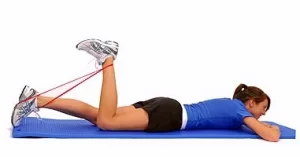
Squats
- Begin by taking a calm stand on the floor.
- Keep your center of focus.
- Take a breath in.
- Make sure your knees are straight.
- With equal weight on both legs, knees should be bent at least ninety degrees.
- Hold your back straight.
- For a short while, maintain this posture.
- After that, take a step back to neutral.
- Then relax.
- Do this exercise five to ten times.
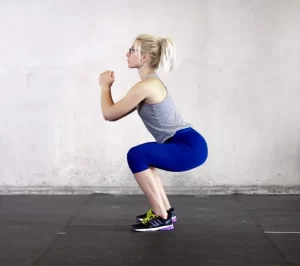
Hamstring wall stretch
- When you lie on your back at the the entrance, your healthy leg should be positioned against the wall.
- To straighten your knee, raise your injured leg up against the wall.
- You should feel your leg’s back extending a little.
- Keep your back straight.
- Avoid bend any knee.
- Hold one heel against a wall and the other on the ground as you continue.
- Do not point your toes at this moment.
- Take a moment to hold this position.
- Return to your neutral posture after that.
- After that, relax.
- Do this five to ten more times.
- On the other leg, perform the exercise once more.
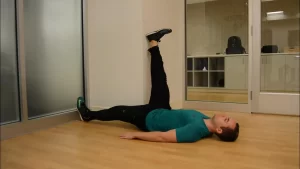
Seated hamstring curl
- Secure the ends of a resistance band to a large object, like a piece of furniture or exercise tools.
- Then you sit down and look directly at it.
- For the purpose of keeping your feet together, cover both of your heels with the loop.
- When you are not able to pull any more far, bend your knee and pull your heel back.
- To get back to where you’d been previously, straighten your knee.
- Next, relax.
- Do this five to ten times over.

Standing hamstring curl
- As you stand, your feet are supposed to be hip-width apart.
- For balance, put your hands on a chair or your waist.
- Now your left leg should bear your entire weight.
- The heel of your right knee should be moving toward your butt as you slowly bend it.
- Maintain your thighs neutral.
- Gently bring your foot down.
- Then relax.
- Continue up the same action with the other leg.
- Do this exercise five to ten times.
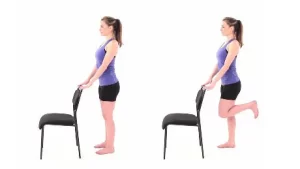
Single leg bridge
- Begin in a comfortable resting down position on the floor or table.
- As you raise your hips as long as your shoulders and knees are in a line that is straight, your abs and buttocks have to support you.
- Tighten your abdominal muscles at the same time, if you were trying to pull your belly button back toward your spine.
- Maintain this position for a short while.
- Lower your hips carefully to the floor while keeping your leg extended to return to the starting position.
- Return to your neutral posture after that.
- Next, relax.
- Repeat the exercise on the other leg.
- Do this exercise five to ten times.
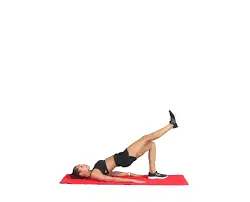
Lateral squat
- To begin, place your feet wider than your hips, pointing your toes and knees forward.
- If it’s more comfortable, you can also slightly spread your feet outside.
- Bend that knee, push your hips back, and shift your weight into your right heel while keeping your left leg straight.
- Try to position your leg parallel to the ground.
- As a means of balancing, you can raise your arms in front of you or hold them to your chest.
- Next, reverse the movement by controlling via your right foot.
- Squeeze your glutes and extend the front of your hips forward during the pause at the top.
- That comes out to one Repetition.
- Return to your neutral posture after that.
- Next, relax.
- Repeat the exercise on the other leg.
- Perform this exercise five or ten times.
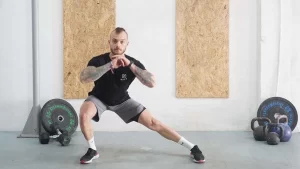
Side-lying leg raise
- Sleep on your right side on the floor or a yoga mat.
- Your body should be in an upright position with your legs raised and your feet arranged on top of one another.
- You can either grasp your head with your elbow bent or place your arm straight on the floor below it for support.
- For added support, extend your left hand in front of you or allow it to rest on your hip or leg.
- Letting go of the breath, raise your left leg off the ground.
- As soon as you feel the muscles contract, stop raising your leg.
- Breathe in, then lower the leg once more so that it touches the right leg.
- Then, go back to your neutral position.
- Next, relax.
- On the other leg, repeat the exercise.
- Do this exercise ten or five times.
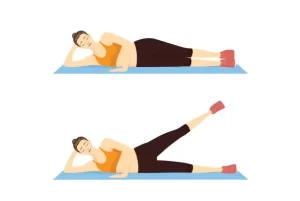
Fire hydrant
- Come to a comfortable hands-and-knee position. (Practicing on a yoga mat or other soft surface could be beneficial.)
- Raise one leg off the ground while extending your knee sideways and upwards.
- Your knee needs to stay bent for the entire exercise.
- While maintaining this posture for a short while, squeeze your glute muscles together.
- Maintaining a stable pelvis and neutral spine can also be achieved by drawing in your abdominal muscles.
- Return your knee to its starting position.
- Next, unwind.
- Repeat the exercise on the other leg.
- Repeat this exercise five or ten times.
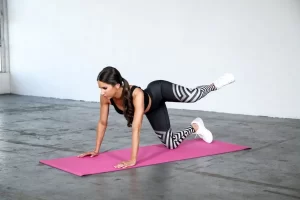
Prone leg raise
- While lying face down, you might want to turn your head to one side if that makes you more comfortable.
- Lift one leg slightly off the ground while maintaining your hips level by contracting your stomach and buttock muscles.
- For a few seconds, maintain this posture.
- Return to your neutral position after that.
- Next, unwind.
- Repeat the exercise on the other leg.
- Repeat this exercise five or ten times.

External hip rotation (sitting)
- With your feet together and knees bent, take a seat.
- Whenever required, use your hands to press your knees down toward the floor.
- Stretch until the movement reaches that point.
- Release the pressure after holding it for a short while.
- Then, go back to your neutral posture.
- Then relax.
- This exercise should be done five or ten times.
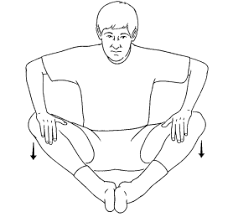
Lunge
- Starting from a standing position, place your feet hip-width apart.
- Put one leg in front of you and the other behind you as you take a slower step forward than you would when walking.
- During the entire process, your foot should remain flat on the ground.
- The heel on your back will rise off the ground.
- Bend your knees to a roughly 90-degree angle as you go down.
- Remember to maintain a straight posture and a contracted core.
- After that, push off strongly with your front leg to return to the starting posture.
- Then relax.
- This exercise should be done five or ten times.
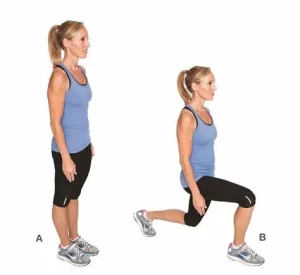
Heel Slide
- Keep your legs straight while you sleep on your back.
- Gently slide one heel back toward the buttock as the knee bends.
- Next, in the opposite direction, gradually extend your heel until your leg is straight.
- Then, go back to your neutral posture.
- Next, unwind.
- Continue with the other leg.
- Perform these exercises five to ten times every day.
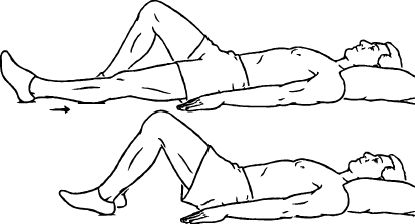
Clam Hip Abduction
- To begin, gently lie on your side with your knees and feet resting on top of one another.
- Bend your hips by 20 to 30 degrees and shift your pelvis forward.
- To open your legs, raise your top knee now.
- For a short while, hold it.
- Once that’s done, slowly return your leg to neutral.
- Next, relax.
- Continue with the other leg.
- Perform these exercises five to ten times every day.
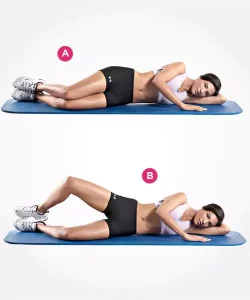
Iliotibial Band Stretch
- Take a side lying position.
- It is best to stretch the side that is on top.
- For stability, keep your lower leg bent.
- Bend your knee and reach back to grab your upper leg’s ankle.
- A pull should be felt at the front of your thigh.
- Gently place the foot of your lower leg on top of your higher knee, maintaining your knee bent.
- To gradually lower your upper knee toward the floor, place your foot on top of it. (The area where the iliotibial band crosses the knee joint should feel like it is pulling on the side of your kneecap.)
- Hold yourself in this position for a short while.
- Then, go back to your neutral posture.
- Then relax.
- On the other leg, repeat the exercise.
- This exercise should be done five or ten times.
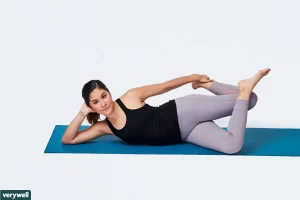
Monster Walks
- Set up a resistance band that surrounds the ankle joint or foot. The loop should measure approximately twelve inches in length.
- Stand up straight, engage your abdominal muscles, and take a 15-inch step to the side while maintaining your straight knees.
- With your other leg, take a slow step sideways in the same direction.
- Maintain control over the movement and elasticity of the band every step of the way
- Step fifteen times in one direction, and then fifteen times the other way.
- Sideways stepping helps strengthen the gluteus medius muscles on the side of your hips.
- Return to your neutral position after that.
- Next, relax.
- Repeat the exercise on the other leg.
- You should perform this exercise five or ten times.
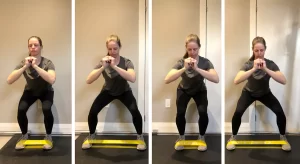
Hip Hikers
- Position yourself on the bottom step of a set of stairs or on a small 8-inch step stool.
- Hold onto something solid if you need support.
- Take a sideways stance with one leg hanging over the edge.
- Lower the leg that is hanging off the edge by lowering your pelvis while maintaining the straight support leg.
- As you perform this, maintain your abs tight.
- After a few seconds of holding the lowered posture, gradually lift your pelvis.
- To do this, you should be able to feel the side of your hip on the stance leg working.
- Then, go back to your neutral posture.
- Next, relax.
- On the other leg, repeat the exercise.
- This is an exercise that you should do five or ten times.
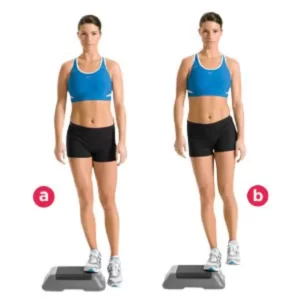
Standing hamstring stretch
- Keep your spine upright and straight when standing.
- Bring the right leg forward in front of the body with the foot flexed, heel pressed into the ground, and toe pointing upward.
- Extend the left knee slightly.
- Gently bend forward and place your hands on your right leg.
- Next, take a neutral stance.
- Then relax.
- On the other leg, repeat the exercise.
- Repeat each leg five to ten times.
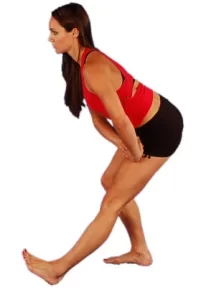
Leg swings
- To open up your hips, perform this dynamic movement from side to side and front to back on both sides.
- Leg swings involve bracing yourself on a stable surface, taking a step back, and beginning to swing your leg side to side like a swinging pendulum.
- Minimize the amount of trunk twisting.
- Next, connect your side with the wall, take support, and begin to swing your leg back and forth to release tension in your glutes, hamstrings, and hip flexors.
- Then, go back to your neutral posture.
- Next, relax.
- Perform the other side.
- You should perform this exercise five or ten times.
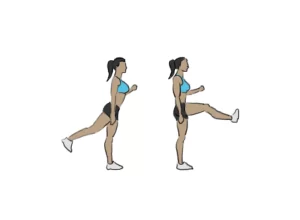
Standing Iliotibial Band Stretch
- Your outside hip will be stretched as a result.
- This exercise requires you to stand with your back to a wall for support.
- Behind your other leg, cross the leg that is closest to the wall.
- Until you feel a stretch on the outside of your hip, lean your hip toward the wall.
- Behind your other leg, cross the leg that is farther away from the wall.
- Hold on to this posture for a short while.
- Return to your neutral position after that.
- Next, relax.
- Perform the opposing side.
- This is an exercise that you should do five or ten times.
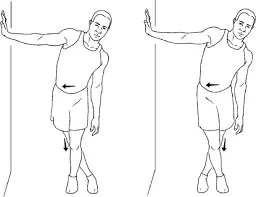
Donkey kick
- Place yourself on the ground, kneeling with your hands.
- Put your knees below your hips and your hands directly below your shoulders.
- To help build a strong back and a stable pelvis, contract your abdominal muscles.
- To maintain a flat back of the neck, put your chin slightly and look down and out.
- Squeeze your glutes to activate them, then lift your right leg up and behind you toward the ceiling while flexing your right foot and maintaining a 90-degree bend in your right leg.
- Adjust your body height so that it is just above the level at which your hips bend or rotate and your lower back arches, suggesting that you have raised it too high.
- Your hips should stay centered on the floor, and your back should stay strong and neutral.
- To complete the exercise with a complete range of motion and appropriate technique, try not to rush your movements.
- Lower your right leg to begin, then raise it back up.
- Return to your neutral position after that.
- Next, relax.
- After finishing all the repetitions on the right side, move on to the left side.
- You should perform this exercise five or ten times.
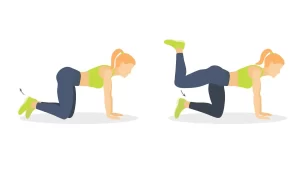
Pelvic tilt
- With your feet parallel to each other, your knees bent, and your arms by your sides, take a floor position.
- Your lower abdominal muscles should be tightened.
- Do not use your leg or buttock muscles to assist you as you lower your abdomen toward your spine.
- Your pelvis will slightly move as a result of this exercise because your lower back will be pressing against the floor.
- After five seconds, release your grip and let your muscles relax.
- Then, go back to your neutral posture.
- Next, relax.
- You should perform this exercise five or ten times.
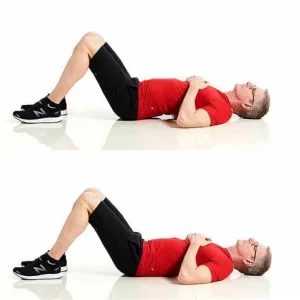
Goddess pose
- Step out slightly on your toes and place your feet wider apart than your shoulders.
- Lift your arms to your shoulders and take the goal-post position.
- Bend your knees toward the sides of the space to lower yourself to the floor.
- Make sure your pelvis has been pushed under and your back is straight by using your core muscles.
- When you reach that point, try to line up your thighs with your feet.
- Hold on to this posture for a short while.
- Return to your neutral position after that.
- Next, relax.
- You should perform this exercise five or ten times.
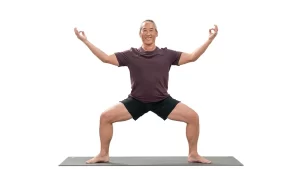
Low lunge
- Take a kneeling position to begin.
- Putting your right foot between your hands, take a step ahead.
- Your foot should be flat on the ground and your thigh should be at a 45-degree angle with the floor as a result of moving your left foot back.
- Keep your right foot pressed solidly into the floor while bending your right knee.
- Straighten your left leg and bend your left toes under, coming up onto them.
- The stretch in your left hip and thigh should be felt.
- Breathe deeply for a few breaths, keeping your left leg straight by using your left quad.
- Perform with the right leg back and the left leg forward by switching sides.
- Return to your neutral position after that.
- Next, relax.
- This is a five or ten-repetition exercise.
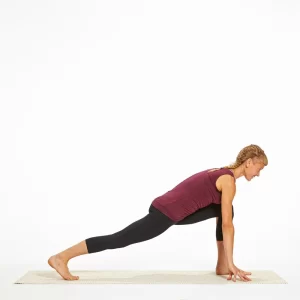
Lying Hamstring Stretch
- Bend both of your knees on the surface of the ground.
- Raise a leg off the ground and bring it up to your chest.
- Place your hands behind your thigh, just below your knee.
- After extending your leg straight, slowly bring it up to your head until you feel a stretch.
- Towels can be looped around your thigh if you find it difficult to clasp your hands behind your leg.
- Holding with hand, bring your leg in toward you.
- Release the hold after a short amount of time.
- Return to your neutral position after that.
- Next, relax.
- This is a five or ten-repetition exercise.
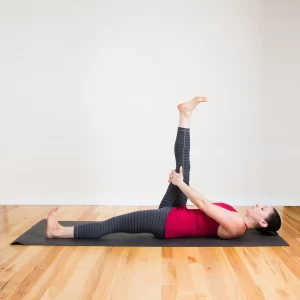
Chair hip flexor stretch
- Your right foot should be placed on the chair in front of you.
- Set your hands on your hips on each side.
- Maintain a straight chest while flexing your core and pelvic floor.
- Be careful not to arch your back.
- Maintain the stretch for as long as is required.
- Return your leg to its starting place carefully.
- Then relax.
- Repeat the steps five to ten times.
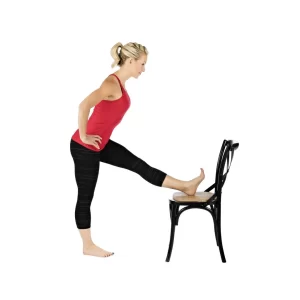
Single Knee to Chest
- Start by lying down on your back on a comfortable surface, such as a yoga mat, blanket, or bed.
- While holding this stretch, keep your head and shoulders in a relaxed position.
- Using both hands behind it, gently pull your left knee toward your chest.
- Hold for a brief period of time.
- Bend your knee slightly or maintain a straight leg in front of you.
- Next, take a neutral position.
- After that, relax.
- Afterward, release and lift your right leg, grasping it behind the knee with both hands.
- Hold your right knee pulled into your chest for a few seconds.
- Repeat steps 5 to 10 on the left and right sides.
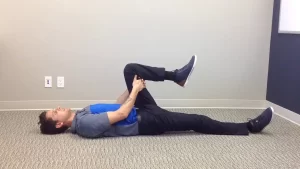
Safety precautions when exercising:
Exercise for hip pain should only be started after consulting with a physician or physical therapist, and it is important to carry out safe and appropriate activities that consider your specific situation.
- If you experience any type of pain during exercise, stop.
- Stay away from stepping (stair climbing) if your groin area is bothering you.
- When exercising, try not to move your hips jerkily.
- It is important to perform all exercises according to protocol, including stretches before each exercise, holds in between exercises, and proper repetitions of each exercise.
- When exercising, dress comfortably so that your body may move freely, and stay away from wearing tight clothing.
- Stretch the tight muscle; if it hurts, that’s okay. However, the stretch shouldn’t cause you to experience any sharp or stabbing pain.
- It is never appropriate to hold your breath when working out. It is recommended that you inhale deeply and exhale gradually through your mouth while exercising. Holding your breath while exercising makes your muscles more tense, which raises the risk of high blood pressure.
- Avoid internal rotation of the hip joint if you have had a total hip replacement. and after the procedure, you should place a pillow between your legs for a few days.
- Once you can move your hip joint across its usual range, you can add strengthening exercises.
When did you stop doing this exercise?
- If your physician suggests that you rest.
- If you lately had a broken leg bone.
- If you feel more pain during any exercise, please say.
- If you get hip pain while exercising, stop.
Good recommendations
- Make an effort to include your workouts into your regular routine.
- Not every exercise needs to be completed in one session.
- It’s not required to perform the entire exercise movement the first time. Use it as a starting point.
- If you have pain with a specific movement, assess your progress every week using this.
- It is typical to experience a significant improvement in pain, movement, and strength after 6 to 12 weeks.
- Participating in general exercise can significantly aid in your recovery, so continue with other enjoyable activities to stay in shape.
- Put on sensible, well-fitting footwear, such as athletic footwear.
Things to avoid doing if you have hip pain:
- Refrain from directly applying pressure to the hip or bending the hip.
- The pain is worsened by sleeping on the side that is affected.
- Avoid sitting for extended periods.
- Trekking and difficult area walking.
- Don’t run or jump when you have hip pain.
- In order to prevent aggravating your hip pain, you should avoid the Warrior Pose, which is described as maintaining balance on one leg.
Lifestyles Changes to Relieve Hip Pain:
A few simple but effective lifestyle adjustments help to prevent the pain from returning in the future in addition to helping to relieve it now.
The following suggested lifestyle adjustments may help with hip pain relief,
- keeping good posture during the day, particularly when seated. Spending too much time sitting with your legs crossed is not a good idea.
- When standing, never place all of your weight on one hip; instead, stand in a way that evenly distributes your weight on both sides.
- Maintain a healthy, balanced diet and regular exercise to keep your body weight at the right level.
- Get moving and go for a walk, or just aim to take more steps each day.
- A comfortable sleeping position is necessary for promoting relaxation in the lower back and hips.
Summary
Hip stretches and exercises can help strengthen muscles, improve range of motion, and reduce pain. There are a lot of exercises available, but individuals can try a variety until they find those that suit them the most, and then include those exercises into a routine. Exercises and stretches that help with strength, mobility, and pain relief are commonly used in physical therapy for the hip.
In the beginning, individuals can try performing basic and adjustable movements. slowly creating an appropriate workout plan can help you reach a stage where the pain significantly goes away. It’s important to be safe when doing these kinds of exercises in addition to being regular. It is important for everyone to be aware of their overload capacity and to never go over it.
Also, a person can create an individualized workout program with a physical therapist to meet their needs. In just a few weeks, simple hip-focused stretches and strength training can help reduce pain and get you back on your feet.
Anyone experiencing severe, ongoing, or increasing hip pain has to consult a physician. It’s important to stop or minimize any activity regimens that worsen hip pain.
FAQ:
Does walking help with hip pain?
One excellent strategy for hip pain relief is to go for walks. If you have issues when you walk every day, there are plenty of other options available to you; as such, you should refrain from walking. Physical therapy can be very beneficial if you have a hip injury. It involves both exercise and heat therapy.
What causes hip pain the most frequently?
One of the most typical causes of hip pain, particularly for adults, is osteoarthritis. Inflammation of the hip joint and a decrease in the cartilage that protect your hip bones are the causes of arthritis. arthritis can cause your hips to become tight and limit your range of motion. This is one way that arthritis can cause pain.
Which exercises should I stay away from if I have severe hip pain?
Exercises involving repetitive hip flexion should be avoided during hip replacement. Hip adduction should also be avoided; instead, put a pillow between your legs. You can perform lunges while performing squats, but you should consider physiotherapy. Avoid exerting yourself while you are hurt. Treat any pain you experience when you walk or run.
Will exercising help with hip pain?
Your hip pain might go away after you rest for three to four days, but you should see a physiotherapist right after. They can give you some light exercise to keep your hip muscles active, maintain your range of motion, and keep your hip from getting tight.
If your hip is painful, should you stretch it?
To reduce hip pain, do mild hip stretches. However, people should stop stretching and get medical help right away if they have hip pain coupled with a fever, edema, or colored skin around the hip.
How long does it take for hip pain to go away?
Many times, long-standing hip issues or new pain should go away on their own in six weeks without the need to consult a doctor
How long after working out does hip pain keep going?
The majority of the time, hip pain has a very straightforward cause, such as overworking during exercise. In this case, the pain usually goes away in a few days and usually comes on by strained or inflamed soft tissues, like tendons.
What relieves hip pain at night?
Make sure you sleep on your back. In order to relieve pressure and maintain your hip position, place a pillow between your knees or slightly behind your back if switching positions during the night is difficult for you. It could be helpful to get extra support from a mattress protector or a more supportive mattress.
What is a home remedy for hip pain?
Take a little break.
For hip joints to heal, rest is essential.
Painkillers are available over the counter.
Treatment with Heat and Cold.
Apply compression.
Perform stretches.
Reduce Your Weight.
Physiotherapy as well as hydrotherapy.
When should I visit a doctor if I’m experiencing hip pain?
If your hip pain was caused by a traumatic incident, like a fall, or if it limits your movement or doesn’t go better with rest, you should consult a doctor.
Which is better for hip pain: heat or ice?
That changes. Ice is without a doubt the greatest choice for acute hip injuries that occur within six weeks of the injury because it can minimize excessive swelling and inflammation that may impede the healing process. Heat is typically advised for ongoing hip pain caused by arthritic and strains.
Which exercise is most beneficial for hip pain?
Heel to buttock exercise
Hip flexion exercise
Hip extension exercise
Hip abduction exercise
Knee lift exercise
Bridging exercise
Leg swings exercise
What is the process for figuring out whether hip pain originates from a joint or muscle?
Hip or groin pain is often the result of problems with the hip joint itself. Issues with the muscles, ligaments, tendons, and other soft tissues surrounding the hip joint are typically the cause of hip pain that radiates to the outside of the hip, upper thigh, or outer buttock.
For people with hip pain, what is the ideal sitting posture?
Maintain Good Posture: Your knees should be at a 90-degree angle as you sit with your feet flat on the floor. Maintain your head in a neutral position, shoulders loose, and back straight. Positions of Sitting, Leaning to one side or crossing your legs may worsen hip tightness.
What are the very first indications of hip difficulties?
Hip pain and discomfort are common early indicators of hip issues that you should be aware of. Limited Mobility. Joint tightening and stiffness.
Is hip pain a major issue?
Hip fractures are one condition that can result in sudden, severe hip pain. Other conditions that affect the hip’s bones or cartilage include arthritis. Such wounds have a chance to cause serious complications. Due to the significant weakening of the bones, it is more common in elderly patients.
When you have hip pain, what kind of posture should you avoid?
Hip bursitis pain can be worsened by deep squats, lateral hip exercises, walking, running, cycling, and a variety of cardio exercise machines due to the pressure they cause. Similar pains can also be experienced when lying on your side, sitting with your legs crossed, or standing with your hips lowered.
Is hip pain a lifelong condition?
In order to restore mobility and relieve chronic hip pain, a total hip replacement may be necessary if the damage to your hip joint is too severe. Hip pain doesn’t have to bother you all the time.
Without an injury, what causes unexpected hip pain?
If you experience sudden hip pain without any problems with your muscles, tendons, or bursae, it might be the result of inflammation within the hip joints. This results in the cartilage degrading, which limits your range of motion and produces painful contact when using the hip joint.
When hip pain occurs, is it better to rest or exercise?
To reduce the stress on your hips, you should concentrate on workouts and exercises that you can perform while sitting or lying down. Because it relieves pressure and weight of the painful hip, exercising in the water is beneficial for hip pain of any kind. To work out your entire body, you could swim laps or do water aerobics.
Why is exercise important for reducing hip pain?
Your pelvic position may be affected by hip pain, which may lead to other issues like knee or back pain. You can put a great deal of these issues to a lack of movement. Hip pain is not limited to lazy people; runners can get it. Hip pain can interfere with everyday activities and even your capacity to play sports well if left untreated.
What causes hip pain the most frequently?
One of the most typical causes of hip pain, especially in adults, is osteoarthritis. Inflammation of the hip joint and a decrease in the cartilage that protects your hip bones are the causes of arthritis. arthritis can cause your hips to become stiff and limit your range of motion. This is one way that arthritis can cause pain.
Which stretches are best for treating hip pain?
Hip and lower back stretch
Hip flexor stretch
Butterfly stretch
Piriformis stretch
The Thomas Stretch
Seated Hamstring Stretch
Hamstring Band Stretch
Hamstring wall stretch
Standing hamstring stretch
Standing Iliotibial Band Stretch
References:
- Hip discomfort stretches and exercises. September 18, 2023. This article, “Spatial News Today, March 25, 2023, “Reference within the text: (Stretches and Exercises for Hip Pain, 2023)
- Arora, S. ( November 7, 2022). stretches and exercises for at-home relief of hip joint pain. Hip Pain Exercises: https://www.hexahealth.com/blog/
Citation within text: (Arora, 2022) - Dutton, A. A. Q. (April 8, 2020). Here Are 4 Exercises You Should Try If You Have Hip Pain. Singapore’s Dr. Dutton Orthopaedic & Sports Medicine Clinic. Exercises for Hip Pain: https://www.drandrewdutton.com/blog/
Reference within the text: Dutton, 2020 - Twelve stretches to help prevent back pain and loosen up tight hips. February 23, 2024. Today.com. Hip-flexor stretches (RCNA16322) can be found at https://www.today.com/health/diet-fitness
Text Citation: (12 Back Pain Relief Exercises to Release Tight Hips, 2024) - Hip-flexor exercises. (n.d). In contrast to arthritis. Exercises for healthy joints and strong hips can be found at https://versusarthritis.org/about-arthritis/exercising-with-arthritis/
Reference inside text: (Hips Exercises, n.d.) - Pt, B. S. August 31, 2023. Easy Hip Pain Stretches to Try. Verywell Medical. Hip pain exercises for physical therapy: https://www.verywellhealth.com/5090171
Inside-Text Reference: (Pt, 2023) - Davis, N. March 15, 2023. Try These 12 Exercises for Lower Back and Hip Pain Relief. Hip-pain exercises from Healthline: https://www.healthline.com/health/pain-relief
Citation within the text: Davis, 2023 - Exercises and stretches for hip pain. Sept. 18, 2023. /articles/325029#knee-lift on Medical News Today Citation inside the text: (Stretching and Exercises for Hip Pain, 2023)
- Image 1, T. (Jan. 30, 2013). Raise Your Knees Supinely. YouTube. jCEinTOnuas can be seen on YouTube. Reference inside text: (2013)
- Image 2, Vanner, C. July 15, 2021. Exercises Seniors Should Try for Hip Pain. Get your daily fix of health headlines with ActiveBeat. Senior stretches and exercises to relieve hip pain can be found at https://activebeat.com/your-health/senior/
Reference within the text: Vanner, 2021 - Image 3, Digital, T. June 16, 2022. excruciating lower back pain? Five stretches to help with stress relief, and waist, hip, and shoulder healing. Times Now. This article, “Unbearable Lower Back Pain: Five Stretches to Find Relaxation and Heal Shoulders, Waist, and Hips,” was published on TimesSnowNews.com in the Health section.
Citation within the text: (Digital, 2022) - Image 4, Post-operative hip exercises after hip fracture repair (standing exercises). (As of now). Hip exercises standing.htm https://www.uhb.nhs.uk/services/trauma-and-orthopaedics/hip-fracture-surgery
In-text Citation: (Standing Exercises for Hip Rehabilitation After Hip Fracture Surgery), n.d. - Image 5, R. M. P. (November 23, 2021). YouTube: Hip Extension Standing. /watch? v=6UxbnQZdgC0 on YouTube
In-text Reference: (2021) - Image 6, Vissco Healthcare Private Limited., Standing Hip Abduction (2021, December 29). Vissco Private Health Inc. Standing hip abduction is one of the physiotherapy exercises offered by Vissco.
In-text Citation: Vissco Healthcare Private Limited., 2021; Standing Hip Abduction - Image 7, Marcin, A. July 24, 2019. How to Perform Butt Kicks and Their Benefits. Healthline. Butt kicks: https://www.healthline.com/health/exercise-fitness
Reference within the text: Marcin, 2019 - Image 9, Five exercises you can do at home with a chair. (As of now). Five chair-based exercises you can do at home: https://inhomecareadelaide.com.au/blog Reference inside text: (5 Chair-based Workouts You Can Perform at Home, n.d.)
- Image 14, W. (September 18, 2011). Hip flexor self-test: Thomas Flexor Stretch. YouTube. YouTube: https://www.youtube.com/watch?v=Q0XiUq9TJ2w
Reference inside text: (2011) - Image 16, Complete Reference: Straight Leg Lifts (n.d.). Straight leg lift. Hinge health. https://www.hingehealth.com/resources/articles/
Citation inside the text: Straight Leg Raises, n.d. - Image 18, The Prone – Performance Health Academy Thera-Band Loop Hamstring Curl (n.d.). Thera-band loop hamstring curl in prone (https://www.performancehealthacademy.com).
In-Text Citation: (Prone – Performance Health Academy, n.d.) Thera-Band Loop Hamstring Curl - Image 20, H. H. (February 21, 2017). YouTube video: “Hamstring Stretch on Wall.” /watch?v=2U4ChnuL3JM on YouTube
In-text Reference: (2017) - Image 21, Luna, D. May 24, 2023. These are 7 Excellent Resistance Band Hamstring Exercises (with Pictures!). Motivate US. https://www.inspireusafoundation.org/exercises/hamstring-and resistance-band/
Within-Text Reference: (Luna, 2023) - Image 23, Glute Bridge with One Leg. (n.d.). Perspiration. Exercises /blogs /exercises /single-leg glute-bridge Reference within the text: (Single-Leg Glute Bridge, n.d.)
- Image 24, On December 9, 2021, G. Ros. The right form, tips, and instructions for performing the Lateral Squat. The best workout tracker and planner app is called Hevy. How to perform a lateral squat: https://www.hevyapp.com/exercises/
Reference inside text: (Ros, 2021). - Image 25, S. (unknown). 650+ Side Leg Lift Royalty-Free Stock Photos, Images, and Pictures – Stock Photo. Side-leg-lift photos at https://www.istockphoto.com
Inside-Text Reference:
(As of now) - Image 26, How to Work Your Glute Using Fire Hydrants | Muscles worked with the fire hydrant exercise? (As of now). The Peach House ®. How-to-do-fire-hydrants-to-target-your-glutes-plus-video: https://www.houseofpeach.com/
In-text Citation: (How to Work Your Glutes with Fire Hydrants | Did Fire Hydrant Exercise Work? - Image 27, ORACOM, n.p. http://www.oracom.fr/k.html for prone leg raises
Citation inside the text:
(ORACOM, undated) - Image 28, On June 30, 2021, Odhaib, K., Alallawee, M., and AL-Mousawi, Z. wp-content/uploads/2021/06/1.pdf on www.anbarjvs.edu.iq. Journal of Veterinary Sciences in Al-Anbar, 14(1). 10.37940/ajvs.2021.14.1.2 can be accessed here. Reference within the text: Odhaib et al., 2021
- Image 30, Heel Slide for Self-Mobilization (Supine). (As of now). The following URL is https://iris.hattiesburgclinic.com/patadv/exkit/Orthopedic/English/0290000710knhp065m French.html
In-Text Citation: (Heel Slide (Supine), Self-Mobilization, n.d.) - Image 31, The Reset (n.d.) presents 5 Clamshell Variations for your Glutes + Core [Video]. Here are five clamshell variations for your glutes core video: https://resetwithus.ca/
Text citation: (The Reset, n.d.) “5 Clamshell Variations for Your Glutes + Core [Video]” - Image 32, Pt, L. I. August 24, 2022. Four Crucial IT Band Stretches. incredibly well-fitting. [https://www.verywellfit.com/stretches-for-the-iliotibial band-2696360]
Citation inside text: (Pt, 2022) - Image 33, Digital, R. (September 19, 2023). The Monster Walk is an exercise to strengthen your hips. Sports Therapy in Burlington. hip-strengthening exercises: https://burlingtonsportstherapy.com/blog/
Citation within the Text: (Digital, 2023) - Image 34, n.d., www.abulm.com. 6204415 in the category of https://www.abulm.com
Reference within the text: www.abulm.com, n.d. - Image 35, hamstring stretches done standing. (n.d.). Standing hamstring stretch: https://geoffmoore.blogspot.com/2011/10.html
“Standing Hamstring Stretch” is the referenced source (n.d.). - Image 36, Swing your legs forward – Go Fitness Plan (n.d.). The Go Fitness Plan website provides exercises for forward-leg swings.
Text citation: (Go Fitness Plan, n.d.) Forward Leg Swings - Image 37, Standing Iliotibial Band Stretch (n.d.). Complete%20Stretching/English/0241000401hip054m_English.html can be accessed at https://iris.hattiesburgclinic.com/patadv/exkit.
Reference: (Iliotibial Band Extension, Standing, n.d.) - Image 38, K. A. M. C. Vlce (2023, March 8). The Proper Way to Perform Donkey Kicks for Stronger Arms, Core, and Glutes. Really Easy. This is the form for the donkey-kick exercise in health and fitness.
Citation inside text: (Vlce, 2023) - Image 40, Earth. (n.d.). Utkata Konasana: The Goddess Pose. Earth. The goddess pose in Utkata, Konasana, according to an article on Gaia.com.
Reference within the text: (Utkata Konasana: The Goddess Pose | Gaia, n.d.). - Image 41, Online Store 52258203 (n.d.). Here is the product details page for Superbloov (5258-2303.html). low lunge Reference within the text: (52258203 – Online Store, n.d.)

